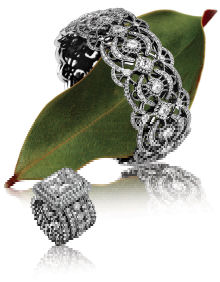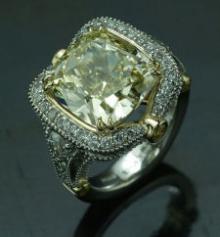“Once limited to low-end, low-quality costume jewelry, offshore competition has been taking a bigger bite out of the highend, precious metals jewelry market.”
By Todd Grimm
The jewelry industry has experienced major changes in the past decade. For many jewelry designers and manufacturers, the impact has been devastating. Over the past ten years, the number of US manufacturers has dwindled by 25 percent, according to the Jewelers Board of Trade. With rising labor costs, soaring precious metals prices and increasing competition from overseas, the forecast for the future is no brighter.
In this business environment, the attributes of the master craftsman—design, innovation and quality—are no longer sufficient for US manufacturers to succeed. Increasingly, design, innovation and quality are associated with overseas fashion jewelry. Once limited to low-end, low-quality costume jewelry, offshore competition has been taking a bigger bite out of the highend, precious metals jewelry market. Lead by China and India, imports of precious metal jewelry are on track to exceed $8 billion in 2005, according to the US Department of Commerce.
The challenge for jewelry manufacturers is to find ways to reduce manufacturing costs without sacrificing quality and artistry. For one designer and manufacturer, technology has been critical in the quest to succeed while maintaining operations in the US. Christopher Designs’ transition from handcrafted master models to technology driven processes began more than a decade ago. Christopher Slowinski, founder and president, believes that without technology, he would have had to succumb to cost pressures and move his manufacturing operations overseas. For him, technology counters competition.

Christopher Designs creates upscale fashion jewelry with its patented Crisscut® diamonds.
Christopher Designs creates upscale fashion jewelry with its patented Crisscut® diamonds.
Christopher Designs specializes in high-quality platinum and gold jewelry with Crisscut® diamonds. From its New York, New York operations, the company designs and manufactures upscale fashion jewelry. Three US patents are testaments to the progressive and innovative style of the company. Slowinski has been awarded patents for invisibly set diamond jewelry; machine set closed end channel anniversary and wedding bands; and a new cut of diamond, the Crisscut. In the 25 years since he founded the company, Slowinski, who learned the trade from master craftsmen, has discovered that these innovations and the quality of his designs are not sufficient to ensure success. To remain competitive and let his designs come to life, he blends handcrafting with technology that includes milling and rapid prototyping.
Slowinski’s technological ventures began in the early 1990s. He realized that the traditional methods could not give him the precision he required, especially for his patented invisible settings, at a cost that would be competitive. He first adopted manually operated 3-axis milling machines and progressed to 4-axis machine tools and computer controlled (CNC) mills. While he was achieving the quality and precision that he needed, he began to realize the limitations. “There were a lot of things I could not do. This meant that handcrafting was the only option, but that was unacceptable due to costs,” stated Slowinski.

Christopher Slowinski, pictured with one of the company’s three Solidscape T66 systems, holds a master model and production piece.
In 1997, Slowinski began looking for alternatives, and it was at this time that he was introduced to the 3D modeling rapid prototyping machines from Solidscape®, Inc. At first, Slowinski was concerned that the quality of the models produced would not satisfy his stringent requirements. “For me, quality is paramount. I will not sacrifice it for cost reductions,” said Slowinski. However, the combination of cost pressures and the limitations of milling convinced Slowinski to give the technology a try. He discovered that, “The technology is very good. There are no limitations.” Christopher Designs now owns three Solidscape T66 systems, including a recently purchased T66 Benchtop.
“Even with the most expensive, sophisticated milling machines, there are things that are not possible,” said Slowinski. “Basically, the applications for Solidscape are extensive. The milling machines cannot help me with hollow pieces, prong pieces and complicated shapes. This is the reason we have Solidscape.”
Even with the capability, Slowinski continues to use the milling machines. In fact, 90 percent of the company’s wedding bands are made from master models cut on the mills. To select the right technology for a piece, Slowinski looks for a balance of speed, precision and cost. Since channel wedding bands are easily machined, he uses the mills. But for nearly everything else that Christopher Designs produces, the company relies on the T66 systems to produce master models of 3D printer jewelry. “All complicated pieces are done with the Solidscape systems because there is no substitute for them unless you do hand work,” stated Slowinski.

This Solidscape master model shows the intricacy and precision that are not possible with other technologies.
The Solidscape T66 systems, which can build with 13 micron (0.0005 inch) layers, construct master models with proprietary thermoplastic ink jetting technology. The thermoplastic, which has wax-like properties, is deposited as small droplets. This additive, layer-by-layer process facilitates the fabrication of complex shapes. The Solidscape master models are used to cast rubber molds for retail pieces and are used as the sacrificial model for casting of platinum and gold jewelry. According to Slowinski, there have been no problems casting his jewelry from a Solidscape master model, which is a problem that he has found with other rapid prototyping systems.
Over the seven years that he has used the 3D printing jewelry technology, Slowinski has seen dramatic improvements in model quality. Asked to compare quality of the Solidscape technology to that of handcrafting, Slowinski stated, “It is as close as possible…no, even better.” He continued, “To match the precision of the Solidscape machines, it would take forever to handcraft a master model.”
Slowinski has successfully joined his classic jewelry training with the revolutionary technological advances of the day. In doing so, he reduces his costs while protecting the quality of the pieces for which he is known.

Made from the Solidscape master model (previous image), this ring features a large center stone.
Slowinski believes that without the Solidscape 3D print jewelry technology, he would have had to move his operations overseas to remain competitive. And yet, he is not married to this technology. To remain competitive and advance his art, he is always on the lookout for new solutions that minimize cost, increase speed, and deliver precision. But, he has yet to find a better alternative.
The jewelry design and manufacturing business has been changed forever. Soaring costs and fierce global competition will either cause further decline in the number of US manufacturers or force the adoption of new methods and new technologies. Although based in fashion and style, jewelry making is not immune to the pressures and challenges that all businesses face. Stylish designs, innovative concepts and superb quality are necessary, but they are not enough to ensure survival. Jewelry manufacturers must change with the times, and as Christopher Designs has shown, technology adoption is a critical part of this change.
Crisscut is a registered trademark of Christopher Designs, Inc., and Solidscape is a registered trademark of Solidscape, Inc.
Customer Profile - Technology Counters Competition
| Industry Jewelry |
